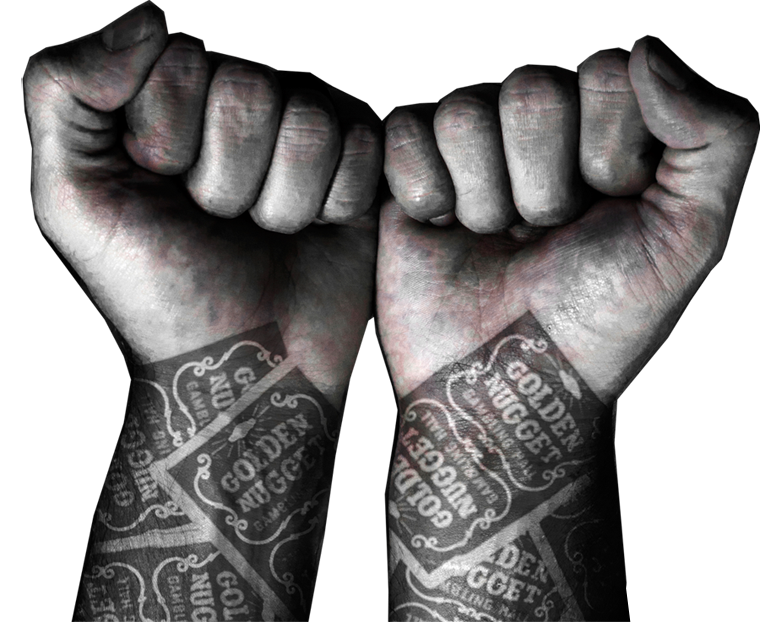Golden Nugget Playing Card History
Golden Nugget Playing Card
History
In The Beginning
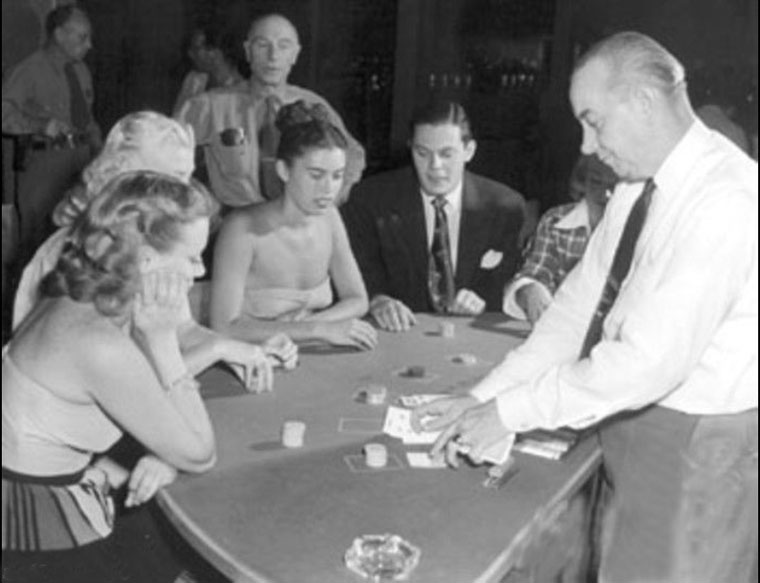
Originally built in 1946, the Golden Nugget Casino is one of the oldest casinos in Las Vegas, Nevada.
Guy McAfee: Founder of the Golden Nugget (1888-1960)

In 1938, Guy McAfee, a crooked Los Angeles cop on the run from the California Law, bought the Pair-O-Dice Club on Highway 91 in Las Vegas, Nevada (Clark County). He converted it into different casinos and saloons until, seven years later, McAfee opened the Golden Nugget Casino in 1946. No pun intended, but he struck gold!
From an existing two-story commercial block at the corner of Second and Fremont Street, McAfee and his investors created a casino that echoed California's history of the western vernacular of the Gold Rush in San Francisco. Now considered part of downtown Las Vegas, it's one of the most attractive tourist destinations in the world.
FUN FACT: Guy McAfee is generally credited for calling the highway that ran through Las Vegas The Strip in a reference to the famous Sunset Strip in his old stomping grounds, Los Angeles.
Incandescent Sign Lineage: Understanding The GNugg
The key to understanding the artwork found on the Golden Nugget Playing Cards is to learn about the history of the different Golden Nugget Casino signs.

The first Golden Nugget sign was a version of the Western-vernacular style of San Francisco's Gold Rush days. Guy McAfee turned to the Salt Lake City, Utah based operation Young Electric Sign Company (YESCO). They were (and still are) a one-stop shop for the full spectrum of sign services including design, fabrication, installation and ongoing maintenance.
YESCO designer, Dick Porter created the original look of the Golden Nugget Casino.
In 1950 Hermon Boernge, YESCO's first art director in Las Vegas, designed a Golden Nugget sign that featured incandescent gilded age gingerbread and a ever-tantalizing golden nugget at the very top. It set the standard ever bigger & brighter on Fremont Street, with the open frame sign measuring 48' wide and tall. For the time period, it was a true marvel.

In 1957, the Golden Nugget contracted with YESCO for another sign. This one was designed by Kermit Wayne. Based on the false front architecture of the Old West, this Victorian fantasy in neon extended well beyond the roof of the building. It was a bullnose (convex) golden structure with Victorian flourishes outlined in red was the background for the word Casino outlined with chasing lights and a huge golden nugget above. The street facades were covered in neon for 100 feet, changing from red to blue every few seconds.

In the late 1980s, the facade was remodeled at the behest of owner Steve Wynn by Fred Doriot of Rissman & Rissman Associates. The sign has been incorporated into a white marble facade. The words Golden Nugget are spelled in red incandescent lettering on a carpet of gold lights along the face of the building. Semi-circular awnings outlined with gold lights shelter the sidewalk. This new understated style is more closely linked to Rodeo Drive than to Fremont Street.
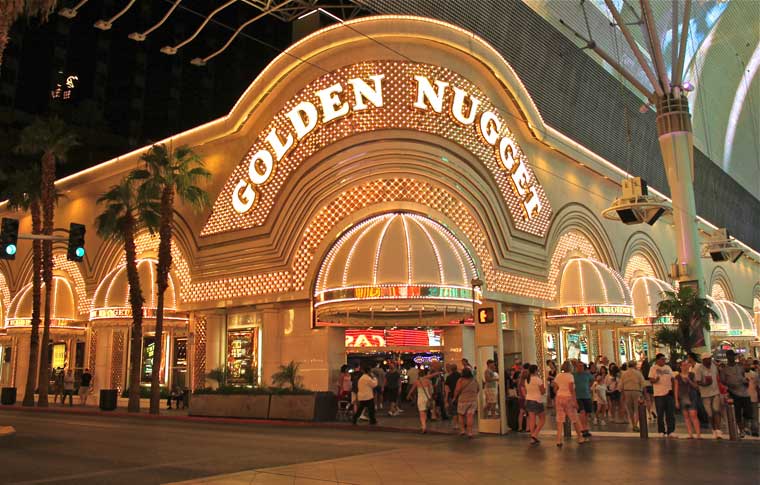
NOTE: All old Golden Nugget signs now rest at the YESCO Boneyard on Las Vegas Blvd.
The Artist Behind The GNuggs - Hermon Boernge
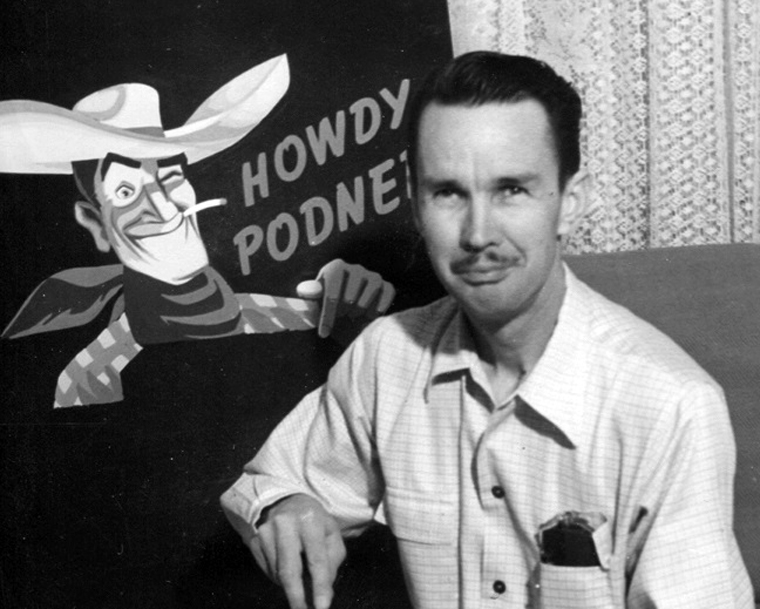
Born January 17,1905 in Corralitos, CA, Hermon Boernge grew up to become a successful commercial artist his entire life.
In 1946, Boernge relocated to the dry climate of Las Vegas. While looking for a space to set up his drafting table, he luckily met Jack Young of Young Electric Sign Company (YESCO) who hired him full time to produce design work for his company.
Boernge was the first designer on staff in Las Vegas for YESCO, and was very soon the director of the art department.
Along with the sign sales team, Boernge would met with the casino owners/developers to sketch out design ideas. From there, early signs were made up in Salt Lake, or Las Vegas depending on the complexity. Boernge and fellow artist and close friend, Kermit Wayne, worked together on many projects. Wayne would build 3-D models of sign designs to gain the satisfaction of the clients.
![Shown clockwise are Hand Schutte, Bob Gilbert (not designers), Jack Larson Sr., Hermon Boernge, Brian Leming, Kermit Wayne, Ray Larson and Ben Mitchem (kneeling). [Photograph courtesy of Brian Leming & YESCO] Shown clockwise are Hand Schutte, Bob Gilbert (not designers), Jack Larson Sr., Hermon Boernge, Brian Leming, Kermit Wayne, Ray Larson and Ben Mitchem (kneeling). Photograph courtesy of Brian Leming & YESCO](images/yesco-sign-employees.jpg)
One could make the strong argument that Hermon Boernge's 1950 sign design would become the artwork used on the backs of the white-bordered GNugg playing cards (as well as many other branded items).
Ultimately, Boernge was directly responsible for beautiful incandescent signs found along Las Vegas Blvd. in front of such hotels as Golden Nugget, Lucky Strike, Mint, Horseshoe, The Concha, Flamingo, Sands, Desert Inn, The Las Vegas Club, El Rancho, and the Pioneer Club's most famous sign - Vegas Vic!
Boernge stepped down as art director around 1964/1965 due to heart issues. None the less, he kept contributing as an artist, just letting go of the management pressures.
Sadly, at the age of 61, Hermon Boernge died on August 5, 1966, in a single car accident when he lost control as a result of a severe heart attack. He was on his way to work at Young Electric Sign Company. His legacy lives on through his wife Nita, his son Jim, and through his sublime artwork like the design found on Golden Nugget Playing Cards.
Master Magician Who Used GNuggs
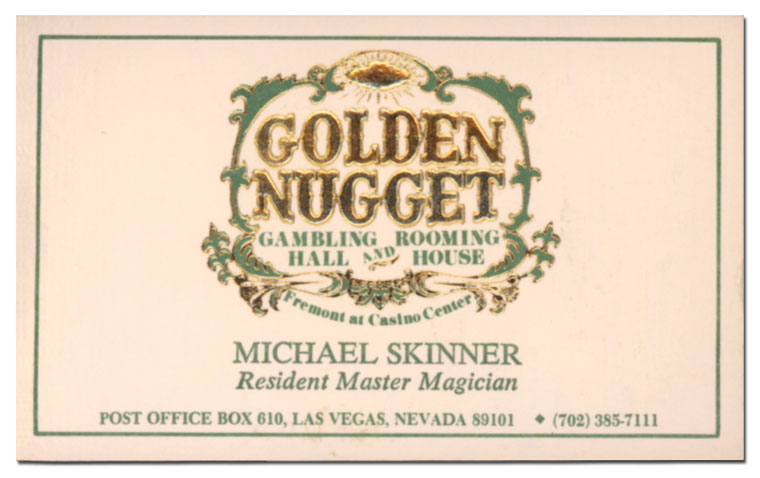
Michael Skinner, the resident magician at Lillie Langtry’s Chinese Restaurant, started in 1975 after Steve Wynn saw him give a close-up performance at the Magic Castle. Steve Wynn is known for collecting precious art, and felt Michael Skinner was living art, and needed him in his casino. Rumor has it he packed up and moved out of Los Angeles on a Sunday, and started work that Monday. Michael Skinner worked at the Golden Nugget Casino in Las Vegas for over 20 years until his death in the late 1990s.
